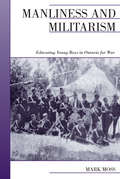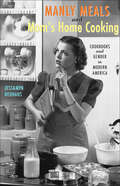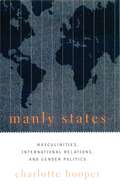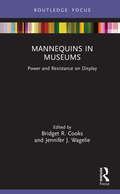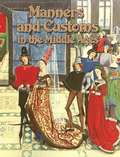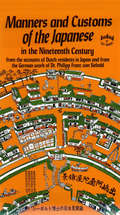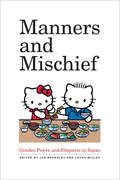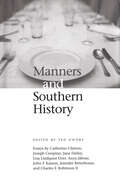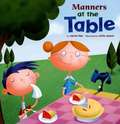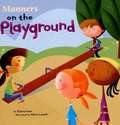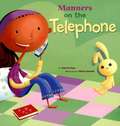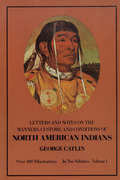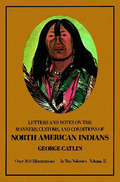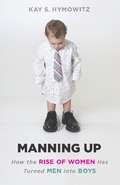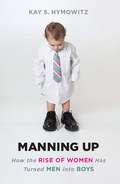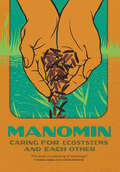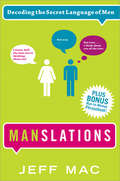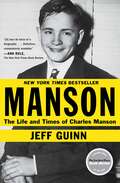- Table View
- List View
Manliness and Militarism
by Mark MossEuphoria swept Canada, and especially Ontario, with the outbreak of World War I. Young men rushed to volunteer for the Canadian Expeditionary Force, and close to 50 per cent of the half-million Canadian volunteers came from the province of Ontario. Why were people excited by the prospect of war? What popular attitudes about war had become ingrained in the society? And how had such values become so deeply rooted in a generation of young men that they would be eager to join this 'great adventure'?Historian Mark Moss seeks to answer these questions in Manliness and Militarism: Educating Young Boys in Ontario for War. By examining the cult of manliness as it developed in Victorian and Edwardian Ontario, Moss reveals a number of factors that made young men eager to prove their mettle on the battlefields of Europe. Popular juvenile literature ? the books of Henty, Haggard, and Kipling, for example, and numerous magazines for boys, such as the Boy's Own Paper and Chums ? glorified the military conquests of the British Empire, the bravery of military men, especially Englishmen, and the values of courage and unquestioning patriotism. Those same values were taught in the schools, on the playing fields, in cadet military drill, in the wilderness and Boy Scout movements, and even through the toys and games of young children.The lessons were taught, and learned, well. As Moss concludes: 'Even after the horrors became known, the conflict ended, and the survivors came home, manliness and militarism remained central elements of English-speaking Ontario's culture. For those too young to have served, the idea of the Great War became steeped in adventure, and many dreamed of another chance to serve. For some, the dream would become a reality.'
Manly Meals and Mom's Home Cooking: Cookbooks and Gender in Modern America
by Jessamyn NeuhausFrom the first edition of The Fannie Farmer Cookbook to the latest works by today's celebrity chefs, cookbooks reflect more than just passing culinary fads. As historical artifacts, they offer a unique perspective on the cultures that produced them. In Manly Meals and Mom's Home Cooking, Jessamyn Neuhaus offers a perceptive and piquant analysis of the tone and content of American cookbooks published between the 1790s and the 1960s, adroitly uncovering the cultural assumptions and anxieties—particularly about women and domesticity—they contain.Neuhaus's in-depth survey of these cookbooks questions the supposedly straightforward lessons about food preparation they imparted. While she finds that cookbooks aimed to make readers—mainly white, middle-class women—into effective, modern-age homemakers who saw joy, not drudgery, in their domestic tasks, she notes that the phenomenal popularity of Peg Bracken's 1960 cookbook, The I Hate to Cook Book, attests to the limitations of this kind of indoctrination. At the same time, she explores the proliferation of bachelor cookbooks aimed at "the man in the kitchen" and the biases they display about male and female abilities, tastes, and responsibilities.Neuhaus also addresses the impact of World War II rationing on homefront cuisine; the introduction of new culinary technologies, gourmet sensibilities, and ethnic foods into American kitchens; and developments in the cookbook industry since the 1960s. More than a history of the cookbook, Manly Meals and Mom's Home Cooking provides an absorbing and enlightening account of gender and food in modern America.
Manly Meals and Mom's Home Cooking: Cookbooks and Gender in Modern America
by Jessamyn NeuhausA study of what American cookbooks from the 1790s to the 1960s can show us about gender roles, food, and culture of their time.From the first edition of The Fannie Farmer Cookbook to the latest works by today’s celebrity chefs, cookbooks reflect more than just passing culinary fads. As historical artifacts, they offer a unique perspective on the cultures that produced them. In Manly Meals and Mom’s Home Cooking, Jessamyn Neuhaus offers a perceptive and piquant analysis of the tone and content of American cookbooks published between the 1790s and the 1960s, adroitly uncovering the cultural assumptions and anxieties—particularly about women and domesticity—they contain.Neuhaus’s in-depth survey of these cookbooks questions the supposedly straightforward lessons about food preparation they imparted. While she finds that cookbooks aimed to make readers—mainly white, middle-class women—into effective, modern-age homemakers who saw joy, not drudgery, in their domestic tasks, she notes that the phenomenal popularity of Peg Bracken’s 1960 cookbook, The I Hate to Cook Book, attests to the limitations of this kind of indoctrination. At the same time, she explores the proliferation of bachelor cookbooks aimed at “the man in the kitchen” and the biases they display about male and female abilities, tastes, and responsibilities.Neuhaus also addresses the impact of World War II rationing on homefront cuisine; the introduction of new culinary technologies, gourmet sensibilities, and ethnic foods into American kitchens; and developments in the cookbook industry since the 1960s. More than a history of the cookbook, Manly Meals and Mom’s Home Cooking provides an absorbing and enlightening account of gender and food in modern America.“An engaging analysis . . . Neuhaus provides a rich and well-researched cultural history of American gender roles through her clever use of cookbooks.” —Sarah Eppler Janda, History: Reviews of New Books“With sound scholarship and a focus on prescriptive food literature, Manly Meals makes an original and useful contribution to our understanding of how gender roles are institutionalized and perpetuated.” —Warren Belasco, senior editor of The Oxford Encyclopedia of American Food and Drink“An excellent addition to the history of women’s roles in America, as well as to the history of cookbooks.” —Choice
Manly States: Masculinities, International Relations, and Gender Politics
by Charlotte HooperMuch has been written on how masculinity shapes international relations, but little feminist scholarship has focused on how international relations shape masculinity. Charlotte Hooper draws from feminist theory to provide an account of the relationship between masculinity and power. She explores how the theory and practice of international relations produces and sustains masculine identities and masculine rivalries.This volume asserts that international politics shapes multiple masculinities rather than one static masculinity, positing an interplay between a "hegemonic masculinity" (associated with elite, western male power) and other subordinated, feminized masculinities (typically associated with poor men, nonwestern men, men of color, and/or gay men). Employing feminist analyses to confront gender-biased stereotyping in various fields of international political theory—including academic scholarship, journals, and popular literature like The Economist—Hooper reconstructs the nexus of international relations and gender politics during this age of globalization.
Mannequins in Museums: Power and Resistance on Display
by Bridget R. Cooks; Jennifer J. WagelieMannequins in Museums is a collection of historical and contemporary case studies that examine how mannequins are presented in exhibitions and shows that, as objects used for storytelling, they are not neutral objects. Demonstrating that mannequins have long histories of being used to promote colonialism, consumerism, and racism, the book shows how these histories inform their use. It also engages readers in a conversation about how historical narratives are expressed in museums through mannequins as surrogate forms. Written by a select group of curators and art historians, the volume provides insight into a variety of museum contexts, including art, history, fashion, anthropology and wax. Drawing on exhibition case studies from North America, South Africa, and Europe, each chapter discusses the pedagogical and aesthetic stakes involved in representing racial difference and cultural history through mannequins. As a whole, the book will assist readers to understand the history of mannequins and their contemporary use as culturally relevant objects. Mannequins in Museums will be compelling reading for academics and students in the fields of museum studies, art history, public history, anthropology and visual and cultural studies. It should also be essential reading for museum professionals who are interested in rethinking mannequin display techniques.
Manners and Customs in the Middle Ages (Medieval World)
by Marsha GrovesDescribes the different manners and customs in dress and behavior that were practiced by medieval kings, knights, ladies, peasants, and religious officials on the battlefield, in a monastery, at weddings, and at funerals.
Manners and Customs of the Japanese in the Nineteenth Century
by Terence Barrow Philipp Franz von SieboldManners and Customs of the Japanese in the Nineteenth Century is a delightful account of the Japanese of Tokugawa Japan.This unique handbook of Japanese manners, customs, history, and singular happenings was published in New York in 1841. Based on the firsthand observations of Dr. Philipp Franz von Siebold of the Dutch trading port Deshima in the years 1823-29, as well as on Spanish, Portuguese, German, and English records of early Japan, it provided us with a very rare picture of what Japan was like in the final years of its feudal period.Dr. von Siebold, the chief contributor, was attached to the Deshima post as a medial adviser and traveled within Japan, befriending and teaching many Japanese who were later to distinguish themselves in Western scientific knowledge. An indiscretion in accepting a map of Japan brought about his banishment by the Edo government and forced return to his native Germany.No collection of books on Japan is complete without a copy of Manners and Customs of the Japanese. It is here reprinted in its entirety from the original edition. Long submerged and virtually forgotten after a century of neglect, it is now made available for a new generation of readers.
Manners and Customs of the Japanese in the Nineteenth Century
by Terence Barrow Philipp Franz von SieboldManners and Customs of the Japanese in the Nineteenth Century is a delightful account of the Japanese of Tokugawa Japan.This unique handbook of Japanese manners, customs, history, and singular happenings was published in New York in 1841. Based on the firsthand observations of Dr. Philipp Franz von Siebold of the Dutch trading port Deshima in the years 1823-29, as well as on Spanish, Portuguese, German, and English records of early Japan, it provided us with a very rare picture of what Japan was like in the final years of its feudal period.Dr. von Siebold, the chief contributor, was attached to the Deshima post as a medial adviser and traveled within Japan, befriending and teaching many Japanese who were later to distinguish themselves in Western scientific knowledge. An indiscretion in accepting a map of Japan brought about his banishment by the Edo government and forced return to his native Germany.No collection of books on Japan is complete without a copy of Manners and Customs of the Japanese. It is here reprinted in its entirety from the original edition. Long submerged and virtually forgotten after a century of neglect, it is now made available for a new generation of readers.
Manners and Customs of the Japanese in the Nineteenth Century
by Terence Barrow Philipp Franz von SieboldManners and Customs of the Japanese in the Nineteenth Century is a delightful account of the Japanese of Tokugawa Japan.This unique handbook of Japanese manners, customs, history, and singular happenings was published in New York in 1841. Based on the firsthand observations of Dr. Philipp Franz von Siebold of the Dutch trading port Deshima in the years 1823-29, as well as on Spanish, Portuguese, German, and English records of early Japan, it provided us with a very rare picture of what Japan was like in the final years of its feudal period.Dr. von Siebold, the chief contributor, was attached to the Deshima post as a medial adviser and traveled within Japan, befriending and teaching many Japanese who were later to distinguish themselves in Western scientific knowledge. An indiscretion in accepting a map of Japan brought about his banishment by the Edo government and forced return to his native Germany.No collection of books on Japan is complete without a copy of Manners and Customs of the Japanese. It is here reprinted in its entirety from the original edition. Long submerged and virtually forgotten after a century of neglect, it is now made available for a new generation of readers.
Manners and Mischief: Gender, Power, and Etiquette in Japan
by Laura Miller Jan BardsleyOffering a concise, entertaining snapshot of Japanese society, Manners and Mischief examines etiquette guides, advice literature, and other such instruction for behavior from the early modern period to the present day and discovers how manners do in fact make the nation. Eleven accessibly written essays consider a spectrum of cases, from the geisha party to gay bar cool, executive grooming, and good manners for subway travel. Together, they show that etiquette is much more than fussy rules for behavior. In fact the idiom of manners, packaged in conduct literature, reveals much about gender and class difference, notions of national identity, the dynamics of subversion and conformity, and more. This richly detailed work reveals how manners give meaning to everyday life and extraordinary occasions, and how they can illuminate larger social and cultural transformations.
Manners and Southern History (Chancellor Porter L. Fortune Symposium in Southern History Series)
by Catherine Clinton John F. Kasson Lisa Lindquist Dorr Jennifer Ritterhouse Anya Jabour Jane Dailey Joseph Crespino Charles F. Robinson IIContributions by Catherine Clinton, Joseph Crespino, Jane Dailey, Lisa Lindquist Dorr, Anya Jabour, John F. Kasson, Jennifer Ritterhouse, and Charles F. Robinson IIThe concept of southern manners may evoke images of debutantes being introduced to provincial society or it might conjure thoughts of the humiliating behavior white supremacists expected of African Americans under Jim Crow. The essays in Manners and Southern History analyze these topics and more. Scholars here investigate the myriad ways in which southerners from the Civil War through the civil rights movement understood manners. Contributors write about race, gender, power, and change. Essays analyze the ways southern white women worried about how to manage anger during the Civil War, the complexities of trying to enforce certain codes of behavior under segregation, and the controversy of college women's dating lives in the raucous 1920s. Writers study the background and meaning of Mardi Gras parades and debutante balls, the selective enforcement of anti-miscegenation laws, and arguments over the form that opposition to desegregation should take. Concluding essays by Jane Dailey and John F. Kasson summarize and critique the other articles and offer a broader picture of the role that manners played in the social history of the South.
Manners at the Table
by Carrie Finn Chris LenschWhy should you chew with your mouth closed? Find out how good manners make mealtime nice for everyone.
Manners in Public
by Carrie Finn Chris LenschWhy do you have to wait in line? What should you say when the waiter brings your food? Find out how you can use good manners in public.
Manners on the Playground
by Carrie Finn Chris LenschDiscusses polite, respectful behavior on the playground.
Manners on the Telephone
by Carrie Finn Chris LenschWhat should you say when you answer the phone? Find out how good manners make the telephone a useful tool for everyone.
Manners, Customs, and Conditions of the North American Indians, Volume I: With Letters And Notes Written During Eight Years Of Travel And Ad (Native American #1)
by George CatlinVolume 1 of the classic account of life among Plains Indians includes fascinating information on ceremonies, rituals, the hunt, warfare, and much more. Total in set: 312 plates.
Manners, Customs, and Conditions of the North American Indians, Volume II (Native American #2)
by George CatlinVolume 2 of the classic account of life among Plains Indians; ceremonies, hunt, warfare, etc. Total in set: 312 plates.
Manning Up
by Kay HymowitzInManning Up, Manhattan Institute fellow andCity Journalcontributing editor Kay Hymowitz argues that the gains of the feminist revolution have had a dramatic, unanticipated effect on the current generation of young men. Traditional roles of family man and provider have been turned upside down as "pre-adult” men, stuck between adolescence and "real” adulthood, find themselves lost in a world where women make more money, are more educated, and are less likely to want to settle down and build a family. Their old scripts are gone, and young men find themselves adrift. Unlike women, they have no biological clock telling them it’s time to grow up. Hymowitz argues that it’s time for these young men to "man up. ”
Manning Up: How the Rise of Women Has Turned Men into Boys
by Kay S. HymowitzEssayist and provocateur Kay Hymowitz explores the unintended consequences of the feminist revolution--the infantilization of young men and the rise of lad culture
Mano Dura Policies in Latin America (Routledge Studies in Latin American Politics)
by Jonathan D. Rosen Sebastián A. CutronaLeading scholars and policy analysts from around the Americas come together to untangle the factors that have fuelled the implementation of mano dura politics, their rising popularity, and impacts across nine widely heterogeneous countries in Latin America. Beginning with a discussion on the concept of mano dura, the editors move to survey various theoretical approaches to punitivism, and later review of the empirical research evaluating different drivers behind the adoption of tough on crime policies. Since hard-line initiatives often have consequences beyond the general goal of reducing violence, they then analyze the impacts of these policing strategies on crime rates and different democratic institutions. Country chapters on Mexico, El Salvador, Honduras, Guatemala, Colombia, Ecuador, Bolivia, Brazil, and Argentina follow a common thematic structure to answer the following questions: What are some of the trends in gangs, organized crime, and violence? How have governments responded to combat crime and violence? What factors have fuelled the implementation of mano dura policies? Why are mano dura policies popular? What have the consequences of these policies been? Mano Dura Policies in Latin America is essential reading to students of Latin American studies, political science, public policy, and criminal justice. It will also interest scholars working on drug trafficking, organized crime, and violence in Latin America.
Manomin: Caring for Ecosystems and Each Other
by Brittany Luby Jane Mariotti Samantha Mehltretter Andrea Bradford Niisaachewan Anishinaabe Nation Dani KasteleinReclaiming crops and culture on Turtle Island Manomin, more commonly known by its English misnomer “wild rice,” is the only cereal grain native to Turtle Island (North America). Long central to Indigenous societies and diets, this complex carbohydrate is seen by the Anishinaabeg as a gift from Creator, a “spirit berry” that has allowed the Nation to flourish for generations. Manomin: Caring for Ecosystems and Each Other offers a community-engaged analysis of the under-studied grain, weaving together the voices of scholars, chefs, harvesters, engineers, poets, and artists to share the plant’s many lessons about the living relationships between all forms of creation. Grounded in Indigenous methodologies and rendered in full colour, Manomin reveals and examines our interconnectedness through a variety of disciplines—history, food studies, ethnobotany, ecology—and forms of expression, including recipes, stories, and photos. A powerful contribution to conversations on Indigenous food security and food sovereignty, the collection explores historic uses of Manomin, contemporary challenges to Indigenous aquaculture, and future possibilities for restoring the sacred crop as a staple. In our time of ecological crisis, Manomin teaches us how to live well in the world, sustaining our relations with each other, our food, and our waterways.
Manorial Capitalism, Enslavement, and the Logic of Dividuation
by Raphael SassowerManorial Capitalism, Enslavement, and the Logic of Dividuation proffers three perspectives on the plantation slave economy of the Antebellum South. The first explores the paternal function as exemplified in the structural authority of the lord of the manor both symbolically and operationally. This figure of masculine authority persisted from the Medieval period to orchestrate what is called here Manorial Capitalism. The second examines the exploitation and alienation that epitomize the logic of capitalism from the plantation economy to the present. And the third deploys retroactively the logic of dividuation to the plantation, a logic that draws its inspiration from neoliberal financial capitalism as well as from anthropological accounts (which distinguish the dividual from the Cartesian-Kantian individual). This book argues that reducing individuals to dividuated components continues to enable a dehumanizing capitalist mindset to fixate on abstracted labor power rather than seeing laboring individuals.
Manslations
by Jeff MacTHE ULTIMATE INTERPRETER OF GUY BEHAVIOR Why doesn't my man get me flowers? Easy - because flowers don't do anything cool. Will I scare him off if I call him first? No way. Well, not unless he's actually terrified of his phone, in which case you likely have bigger problems. Why can't he just talk to me about our relationship? Yeah . . . and how come a gazelle never waits around to see if that lion is friendly? Men sometimes seem impossible to understand. But it turns out they're about as easy to read as coloring books - if you know what you're looking for. Manslations answers all these questions and more in this hilarious - and honest - guide to what men say, who they are, and why they behave the way they do. "When that guy told you - within thirty seconds of introducing himself at the bar - that he drives a hybrid because he cares about the environment, the manslation is that he was trying to work his way into your bikini areas. "Manslations reveals the golden rule that helps you figure out what never to worry about (and what to lose sleep over), plus the two key questions that will help unlock the meaning behind even the most confusing male actions. Capped off by a man-to-woman phrasebook, this is the only relationship guide you'll ever need.
Manson: The Life and Times of Charles Manson
by Jeff GuinnThe New York Times bestselling, authoritative account of the life of Charles Manson, filled with surprising new information and previously unpublished photographs: &“A riveting, almost Dickensian narrative…four stars&” (People).More than forty years ago Charles Manson and his mostly female commune killed nine people, among them the pregnant actress Sharon Tate. It was the culmination of a criminal career that author Jeff Guinn traces back to Manson’s childhood. Guinn interviewed Manson’s sister and cousin, neither of whom had ever previously cooperated with an author. Childhood friends, cellmates, and even some members of the Manson family have provided new information about Manson’s life. Guinn has made discoveries about the night of the Tate murders, answering unresolved questions, such as why one person near the scene of the crime was spared. Manson puts the killer in the context of the turbulent late sixties, an era of race riots and street protests when authority in all its forms was under siege. Guinn shows us how Manson created and refined his message to fit the times, persuading confused young women (and a few men) that he had the solutions to their problems. At the same time he used them to pursue his long-standing musical ambitions. His frustrated ambitions, combined with his bizarre race-war obsession, would have lethal consequences. Guinn’s book is a “tour de force of a biography…Manson stands as a definitive work: important for students of criminology, human behavior, popular culture, music, psychopathology, and sociopathology…and compulsively readable” (Ann Rule, The New York Times Book Review).
